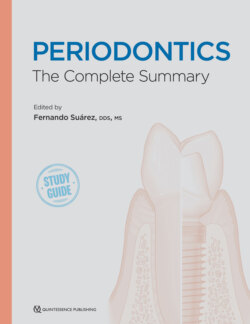Читать книгу Periodontics - Fernando Suarez - Страница 54
На сайте Литреса книга снята с продажи.
Gingivitis
ОглавлениеPlaque-induced or dental biofilm–induced gingivitis refers to an inflammatory response of the gingival tissues occurring secondary to bacterial plaque accumulation around the gingival margin.40,50 In order to understand the initiation and progression of this inflammatory condition, Löe et al40 performed an experimental gingivitis study. For this investigation, patients with healthy gingiva were asked to withdraw from all oral hygiene methods until the inflammatory changes were observed. Gingivitis developed within 10 days for three subjects, while for the remaining nine subjects it took between 15 and 21 days. Once these inflammatory changes were observed, patients were instructed to resume oral hygiene methods, and gingival health was regained within a week, also reestablishing the original bacterial flora. While simple in design, this study proved several concepts: (1) the bacterial plaque is the etiology of the disease, (2) the differences in the response suggest different progressions models and susceptibility of patients, and (3) gingivitis is reversible.40
In addition, bacteriologic changes were also evaluated. Healthy gingiva presented with small groups of bacteria mainly composed of gram-positive cocci and short rods. The initial stages of plaque accumulation (ie, 1 to 2 days) yielded an increase in rods and cocci followed by an accumulation of filamentous forms and fusobacteria (2 to 4 days) accompanied by further leukocyte accumulation. During the last phase, the predominant bacterial flora was characterized by Vibrio spp and spirochetes with still a large number of cocci, rods, and filamentous organisms as well as a heavy leukocyte accumulation. One year later, the same group performed a follow-up investigation demonstrating the increase in complexity of the microbial flora when gingivitis was established.51 During the next decades, several other investigations focused on the progression and the different stages of gingivitis.52–54 It is important to mention the methodologic differences among these studies. Page and Schroeder52 reviewed the progression of gingivitis based on animal and human studies. Seymour et al54 carried out experimental gingivitis in dental students. Last, Kornman et al53 reviewed the relationship between bacterial challenge and host immunity during the progression of gingivitis.
Clinical signs and symptoms of plaque-induced gingivitis include edema, bleeding, erythema, tenderness, gingival enlargement, and halitosis.55,56 In addition, the severity of these symptoms can vary among individuals and can be influenced by a variety of anatomical and restorative factors.57,58 While gingivitis does not directly cause tooth loss, the prevention and early treatment of this condition represents a key component of the prevention of periodontitis.59
Dental plaque–induced gingivitis can also be associated with dental biofilm alone, or on the other hand, it can be potentially modified or mediated by a variety of local and systemic factors including sex steroid hormones, hyperglycemia, leukemia, smoking, malnutrition, certain subgingival restorations, and hyposalivation.50 Moreover, drug-influenced gingival enlargements can also occur secondary to antiepileptic drugs, certain calcium channel blockers, immunoregulators, and high-dose oral contraceptives.50 It is important to bear in mind that while bacteria are necessary to develop gingivitis in conjunction with these medications, not all patients taking these drugs will experience gingival enlargement.
